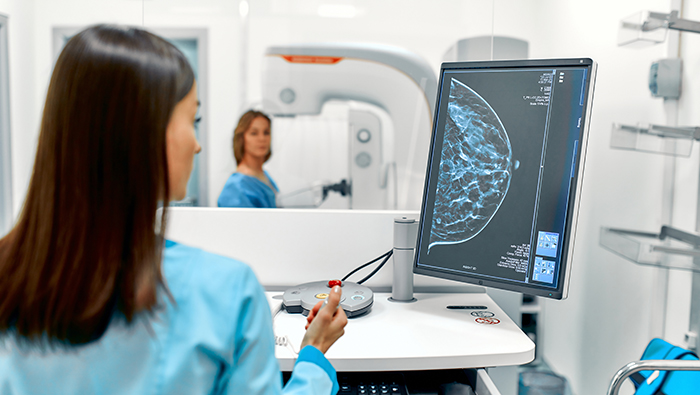
October is Breast Cancer Awareness Month, an annual campaign to raise awareness about the impact of breast cancer. Since 1985, individuals, businesses, and communities have come together every October to show their support for the many people affected by breast cancer. Breast Cancer Awareness Month can be a time to reflect, give back, or even celebrate.
It seems that we all know someone who has had breast cancer. And to see these statistics, it’s no wonder. We see the pink ribbons on clothing and cars, and hear about all the well-attended events held in October in commemoration of Breast Cancer Awareness Month (or we used to, anyway, before COVID struck). Indeed, breast cancer has reached many people and shattered or taken many lives. So how do we keep ourselves safe from this killer disease?
Most healthcare providers agree that the answer to that question is Mammography. Having regular mammograms taken is the best tool we have for detecting and fighting breast cancer.
But what exactly is mammography? Mammography refers to a test which produces mammograms: x-ray images of the breast that are studied by trained radiologists to detect signs of breast cancer. Previously, mammograms were stored on film, but now we have digital mammography, which allows the images to be stored on computers, making them easier to share with multiple healthcare providers for review. With digital mammography, certain sections of the image can also be darkened, lightened, or enlarged to be seen more closely.
And now there’s 3D Digital Mammography (also known as Breast Tomosynthesis or Digital Tomosynthesis) which some studies have shown to be more effective in detecting breast cancers than 2D mammography, but the benefits of this tool are still being studied.
Mammography is so effective because it is used to detect breast cancer early, before there are any symptoms, when the chances of survival from breast cancer are at their best. Besides serving as a screening tool in a clinical breast exam, mammography can also be used as a follow-up test after an abnormality has been detected on a breast. This is called a diagnostic mammogram. Though a diagnostic mammogram cannot actually diagnose breast cancer, it can determine if the abnormality resembles it enough to warrant a biopsy, which can confirm or rule out a malignancy.
Recommendations for when women should start getting mammograms vary. The American Cancer Association recommends that women who are at average risk for breast cancer start getting yearly mammograms at ages 40 – 44, if they choose to do so, and strongly recommends yearly mammography tests for healthy women aged 45 – 54. They also maintain that a woman should have a mammography test once every two years after the age of 55.
Recommendations for when women should stop having mammography tests also vary, with the American Cancer Association recommending that a healthy woman continue to have them every two years as long as she remains healthy, and the US Preventive Services Task Force reporting that there isn’t enough evidence to recommend for or against them in women above the age of 75. Recommendations may differ for women who are at higher than average risk of breast cancer due to genetic predisposition and other risk factors.
Breast cancer in men is very rare – less than one percent of all breast cancer in the US occurs in men – and breast cancer screening is largely not recommended for men unless they are at an increased risk due to an inherited gene mutation.
Though regular mammography can reduce the chances of patients dying from breast cancer, the benefits vary by age, with women ages 50 – 69 gaining the most benefits from it, since breast cancer in patients under the age of 50 is less common. It is estimated that with regular mammography tests out of 10,000 women, 0-9 deaths from breast cancer are avoided for women aged 39 – 49, while 2 -17 deaths of women aged 50 – 59 are avoided, and 11 – 32 deaths are avoided in women aged 60 – 69, according to the US Preventative Task Force.
But this is not a perfect test. Though mammography has saved many lives, some women who have regular mammograms taken still get a diagnosis of breast cancer, and some still die from this disease.
Conversely, false positive results, over-diagnosis and over-treatment involving the use of mammograms are still possible, and not all that uncommon. Out of 10,000 women who are age 40 to 49, 1,212 receive a false positive diagnosis. The percentage of false positives decreases with age, with 932 false positives found in the same number of women age 50 – 59, 808 in women age 60 – 69, and 696 in those age 70 – 74.
False positives sometimes are the result of the detection small, invasive cancers which don’t always cause problems for the patient if left untreated. Sometimes, these cancers will shrink and disappear on their own, but it is impossible to detect which small invasive cancers will remain benign or shrink, and which will grow to become fatal to the patient. Sometimes, the result on a mammogram leads to a biopsy that does not show cancer. While this is a positive outcome for an individual patient, collectively, it adds up to a lot of extra medical procedures, costs, and anxiety for the thousands of women who get a false positive diagnosis.
However, despite the prevalence of false positives derived from mammograms, mammography is still considered the most effective tool for detecting breast cancer that we have today. Most healthcare organizations maintain that the benefits of mammography outweigh the risks of false positives and potential over-diagnosis and over-treatment. It is widely recommended that each woman who has reached her 40s speak with a healthcare provider who, guided by her breast cancer risk profile, can advise her about getting regular mammography tests.